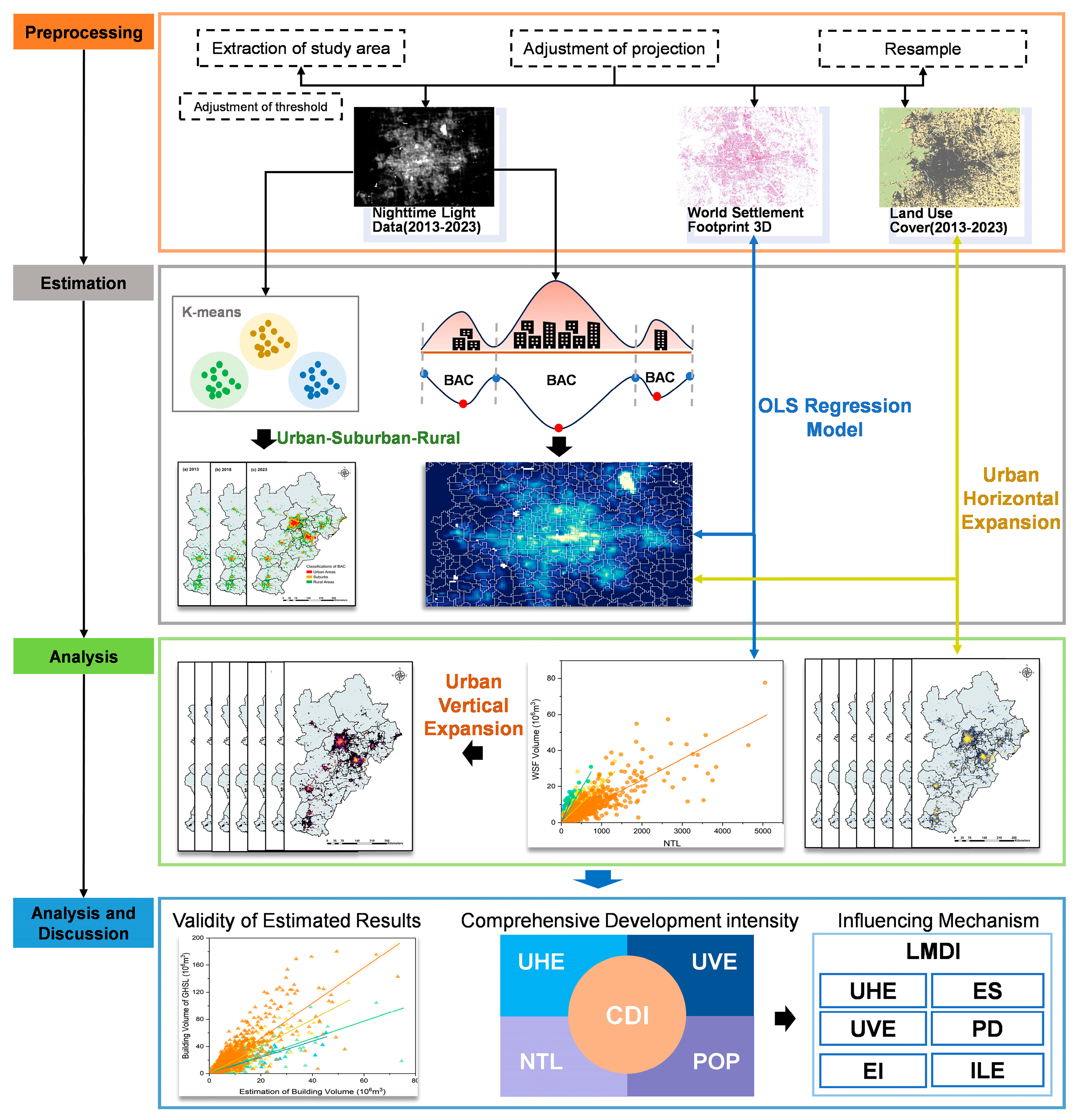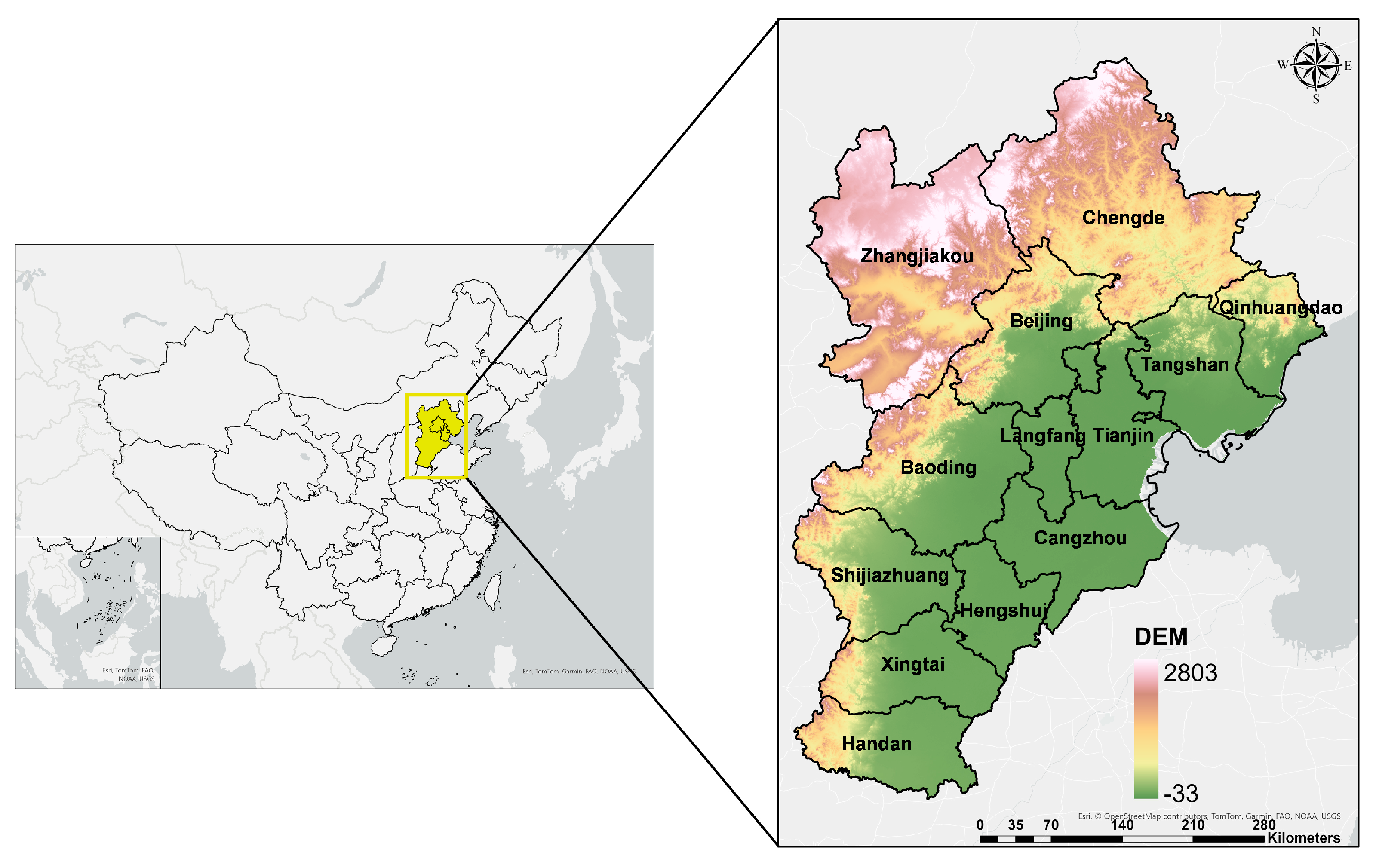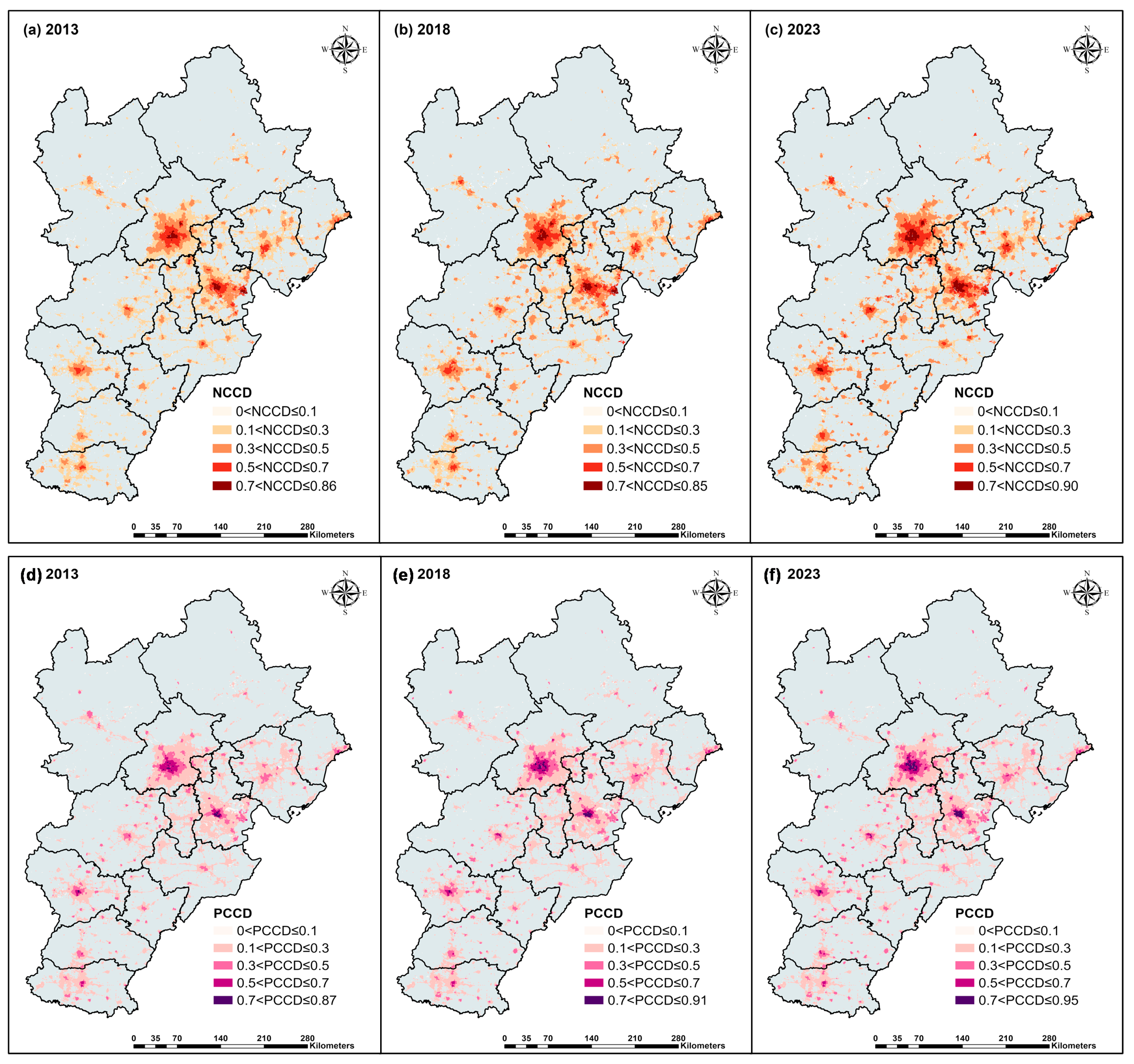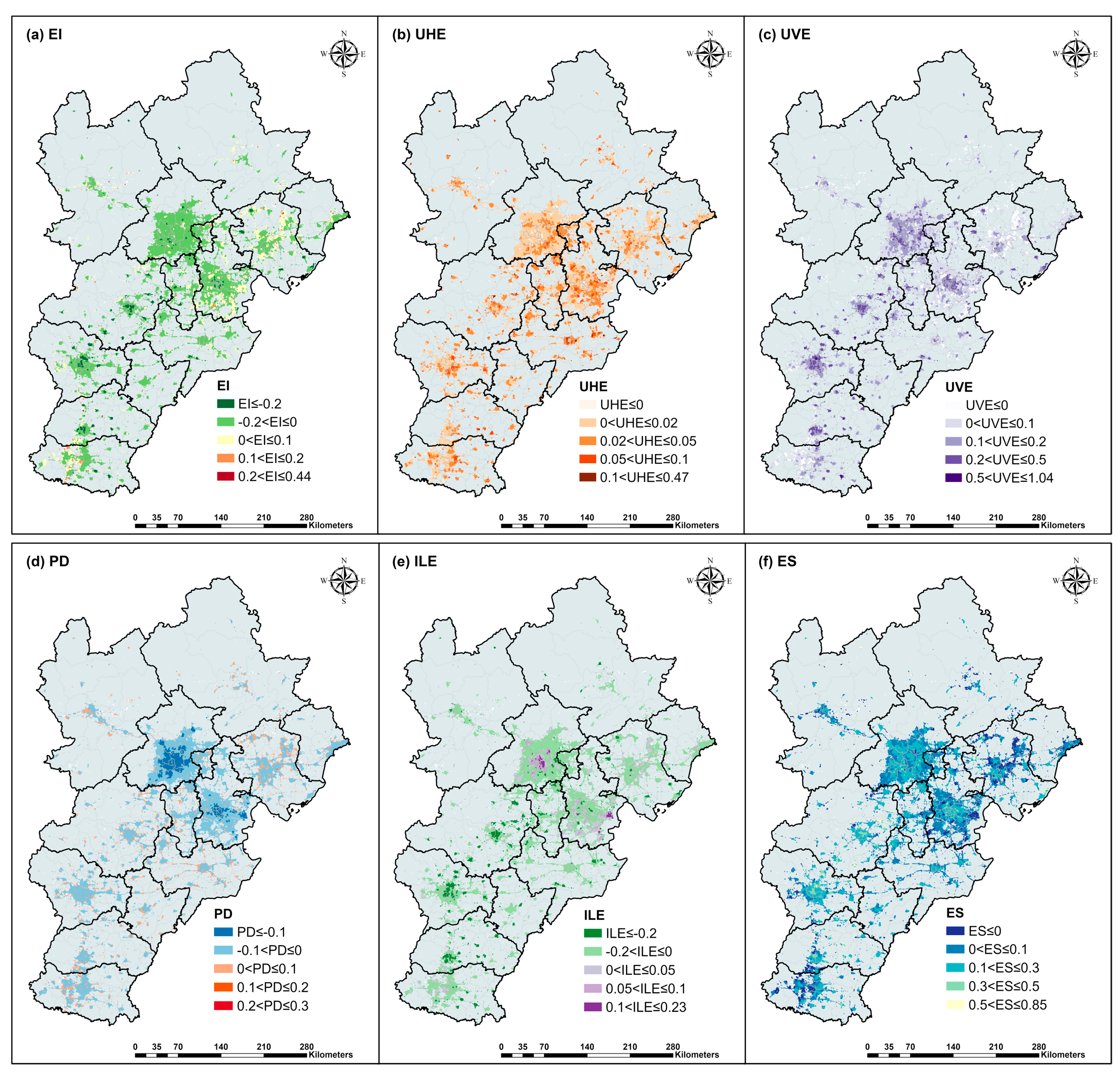Multi-Dimensional Analysis of Urban Growth Characteristics Integrating Remote Sensing Data: A Case Study of the Beijing–Tianjin–Hebei Region
Abstract
1. Introduction
2. Materials and Methods
2.1. Study Area
2.2. Urban Horizontal Growth and Vertical Growth
2.2.1. Division of Built-Up Cells
- (1)
- The simulation of valleys and peaks. The pixels with an NTL value of 0 were removed, and the reciprocal of the processed image was used. This means that pixels with low NTL values became larger when processed, while pixels with high NTL values became smaller when processed. They can be regarded as valleys and peaks.
- (2)
- The confirmation of the flow direction. Flow direction generally goes from peaks to valleys, that is, from high-value areas to low-value areas. By using the flow direction tool of ArcGIS, the direction of each pixel to the steepest descent adjacent point was confirmed according to the D8 flow direction method. The original NTL is the trend of flow from low-value areas to high-value areas, which shows that the low-value areas surround the high-value areas.
- (3)
- The confirmation of BUCs. The convergence of similar flow directions forms a watershed. Based on the basin analysis tool of ArcGIS, the convergence ranges formed by flow directions with the same convergence points were divided. Regarding the original NTL, the area affected by the same building center was regarded as a convergence range, that is, each convergence range represented the building center and its hinterland. Because the BUCs were used to represent the regional center and hinterland, the BUCs with an area of less than 750,000 square meters were removed from the total sample and finally, 6338 samples were used as research samples.
2.2.2. Estimation of UHE and UVE
2.2.3. Comprehensive Development Intensity
2.2.4. Coupling Coordination Analysis
2.2.5. Decomposition of Influencing Factors of Change in CDI
2.2.6. Identification of USR Areas
2.3. Data Sources
3. Results
3.1. Characteristics of UHE and UVE
3.1.1. Overall Trends of UHE and UVE
3.1.2. Spatiotemporal Characteristics of UHE and UVE
3.2. Analysis of Comprehensive Development Intensity
3.2.1. Spatial Characteristics and Changes in CDI
3.2.2. CCD Between CDI and Economic Activities and Population
3.3. Influencing Mechanism of Change in CDI
3.3.1. Decomposition of Influencing Factors for Changes in the CDI of BUCs
3.3.2. Decomposition of Influencing Factors by Regions
4. Discussion
4.1. Validity and Limitations
- (1)
- For the low-luminous-efficiency group, the errors were more pronounced in the case of BUCs with relatively large-scale building volumes, where most estimations underestimated the actual building volume (Figure 9a). The luminous efficiency groups were mainly located in rural areas with small forms and dispersed distributions (Figure S1). Because of the difficulty in accurately capturing socioeconomic activities in remote areas using NTL, there is a potential for the underestimation of related factors [74,75]. For example, factories or agricultural facilities were generally underestimated in terms of their building volumes. The high-luminous-efficiency group showed both an overestimation and underestimation of building volumes (Figure 9d). The underestimated BUCs in this group were mainly concentrated in the core urban areas, while overestimated BUCs in this group were located in the peripheral areas of the core urban areas (Figure S16). In the core urban areas, NTL cannot always accurately reflect the actual building volume because of the saturation effect, leading to an underestimation of building volumes in the core area. Conversely, the peripheral areas of the core urban areas were affected by nighttime light spillover, causing an overestimation of building volumes in these areas.
- (2)
- The GHSL building volume data in 2020 were used as validation data. The GHSL building volume dataset was generated by the product of the GHSL built-up surface spatial raster dataset and GHSL building height with a resolution of 100 m [76]. The GHSL built-up surface dataset was mainly derived from Sentinel-2 composite and Landsat multitemporal data. The GHSL building height was derived from AW3D30, SRTM30, and Sentinel-2 composite data (2018). However, the WSF3d data were primarily based on the World Settlement Footprint dataset, amplitude images (TDX-AMP) collected between 2011 and 2013, and the TanDEM-X elevation model (TDX-DEM) with a resolution of 90 m [54]. The differences in data sources, collection times, and methodological frameworks between WSF3d and GHSL led to discrepancies, with GHSL showing higher building volumes compared to WSF3d (Figure 9e–h).
- (3)
- The groups of luminous efficiency showed a spatial trend of transition from rural to urban centers across Groups 1, 2, 3, and 4. Specifically, the high-luminous-efficiency group primarily included buildings in urban areas. Although the sample numbers were consistent across four groups, the spatial pattern reveals that the high-luminous-efficiency group occupied the largest area. This suggested that the samples in this group were generally larger in building volume. In addition to the saturation and spillover effects of NTL, the larger building volume was one of the reasons why the estimated building volumes for the high-luminous-efficiency group differed significantly from the existing dataset.
4.2. Implications for Sustainable Urban Growth and Planning
5. Conclusions
Supplementary Materials
Author Contributions
Funding
Data Availability Statement
Acknowledgments
Conflicts of Interest
References
- Department of Economic and Social Affairs, Population Division World Population Prospects 2024; United Nations: New York, NY, USA, 2024.
- Seto, K.C.; Güneralp, B.; Hutyra, L.R. Global forecasts of urban expansion to 2030 and direct impacts on biodiversity and carbon pools. Proc. Natl. Acad. Sci. USA 2012, 109, 16083–16088. [Google Scholar] [CrossRef] [PubMed]
- Martellozzo, F.; Amato, F.; Murgante, B.; Clarke, K.C. Modelling the impact of urban growth on agriculture and natural land in Italy to 2030. Appl. Geogr. 2018, 91, 156–167. [Google Scholar] [CrossRef]
- Chen, G.; Li, X.; Liu, X.; Chen, Y.; Liang, X.; Leng, J.; Xu, X.; Liao, W.; Qiu, Y.A.; Wu, Q.; et al. Global projections of future urban land expansion under shared socioeconomic pathways. Nat. Commun. 2020, 11, 537. [Google Scholar] [CrossRef] [PubMed]
- Güneralp, B.; Reba, M.; Hales, B.U.; Wentz, E.A.; Seto, K.C. Trends in urban land expansion, density, and land transitions from 1970 to 2010: A global synthesis. Environ. Res. Lett. 2020, 15, 044015. [Google Scholar] [CrossRef]
- Chakraborty, S.; Maity, I.; Dadashpoor, H.; Novotnẏ, J.; Banerji, S. Building in or out? Examining urban expansion patterns and land use efficiency across the global sample of 466 cities with million+ inhabitants. Habitat Int. 2022, 120, 102503. [Google Scholar] [CrossRef]
- He, Q.; Zeng, C.; Xie, P.; Tan, S.; Wu, J. Comparison of urban growth patterns and changes between three urban agglomerations in China and three metropolises in the USA from 1995 to 2015. Sustain. Cities Soc. 2019, 50, 101649. [Google Scholar] [CrossRef]
- Wu, R.; Li, Z.; Wang, S. The varying driving forces of urban land expansion in China: Insights from a spatial-temporal analysis. Sci. Total Environ. 2021, 766, 142591. [Google Scholar] [CrossRef]
- Zhang, Q.; Su, S. Determinants of urban expansion and their relative importance: A comparative analysis of 30 major metropolitans in China. Habitat Int. 2016, 58, 89–107. [Google Scholar] [CrossRef]
- Liang, X.; Liu, X.; Li, X.; Chen, Y.; Tian, H.; Yao, Y. Delineating multi-scenario urban growth boundaries with a CA-based FLUS model and morphological method. Landsc. Urban Plan. 2018, 177, 47–63. [Google Scholar] [CrossRef]
- Huang, M.; Wang, Z.; Pan, X.; Gong, B.; Tu, M.; Liu, Z. Delimiting China’s Urban Growth Boundaries Under Localized Shared Socioeconomic Pathways and Various Urban Expansion Modes. Earth’s Future 2022, 10, e2021EF002572. [Google Scholar] [CrossRef]
- Liu, X.; Wang, M.; Qiang, W.; Wu, K.; Wang, X. Urban form, shrinking cities, and residential carbon emissions: Evidence from Chinese city-regions. Appl. Energy 2020, 261, 114409. [Google Scholar] [CrossRef]
- Wolff, M.; Wiechmann, T. Urban growth and decline: Europe’s shrinking cities in a comparative perspective 1990–2010. Eur. Urban Reg. Stud. 2017, 25, 122–139. [Google Scholar] [CrossRef]
- Fu, Y.; Li, J.; Weng, Q.; Zheng, Q.; Li, L.; Dai, S.; Guo, B. Characterizing the spatial pattern of annual urban growth by using time series Landsat imagery. Sci. Total Environ. 2019, 666, 274–284. [Google Scholar] [CrossRef] [PubMed]
- Huang, H.; Chen, P.; Xu, X.; Liu, C.; Wang, J.; Liu, C.; Clinton, N.; Gong, P. Estimating building height in China from ALOS AW3D30. ISPRS J. Photogramm. Remote Sens. 2022, 185, 146–157. [Google Scholar] [CrossRef]
- Labetski, A.; Vitalis, S.; Biljecki, F.; Arroyo Ohori, K.; Stoter, J. 3D building metrics for urban morphology. Int. J. Geogr. Inf. Sci. 2022, 37, 36–67. [Google Scholar] [CrossRef]
- Li, X.; Zhou, Y.; Gong, P.; Seto, K.C.; Clinton, N. Developing a method to estimate building height from Sentinel-1 data. Remote Sens. Environ. 2020, 240, 111705. [Google Scholar] [CrossRef]
- Ren, C.; Cai, M.; Li, X.; Shi, Y.; See, L. Developing a rapid method for 3-dimensional urban morphology extraction using open-source data. Sustain. Cities Soc. 2020, 53, 101962. [Google Scholar] [CrossRef]
- Frolking, S.; Mahtta, R.; Milliman, T.; Esch, T.; Seto, K.C. Global urban structural growth shows a profound shift from spreading out to building up. Nat. Cities 2024, 1, 555–566. [Google Scholar] [CrossRef]
- Lemoine-Rodríguez, R.; Inostroza, L.; Zepp, H. The global homogenization of urban form. An assessment of 194 cities across time. Landsc. Urban Plan. 2020, 204, 103949. [Google Scholar] [CrossRef]
- He, S.; Yu, S.; Li, G.; Zhang, J. Exploring the influence of urban form on land-use efficiency from a spatiotemporal heterogeneity perspective: Evidence from 336 Chinese cities. Land Use Policy 2020, 95, 104576. [Google Scholar] [CrossRef]
- Güneralp, B.; Zhou, Y.; Ürge-Vorsatz, D.; Gupta, M.; Yu, S.; Patel, P.L.; Fragkias, M.; Li, X.; Seto, K.C. Global scenarios of urban density and its impacts on building energy use through 2050. Proc. Natl. Acad. Sci. USA 2017, 114, 8945–8950. [Google Scholar] [CrossRef]
- Chen, Y.; Shu, B.; Zhang, R.; Amani-Beni, M. LST determination of different urban growth patterns: A modeling procedure to identify the dominant spatial metrics. Sustain. Cities Soc. 2023, 92, 104459. [Google Scholar] [CrossRef]
- He, Q.; He, W.; Song, Y.; Wu, J.; Yin, C.; Mou, Y. The impact of urban growth patterns on urban vitality in newly built-up areas based on an association rules analysis using geographical ‘big data’. Land Use Policy 2018, 78, 726–738. [Google Scholar] [CrossRef]
- Xian, S.; Li, L.; Qi, Z. Toward a sustainable urban expansion: A case study of Zhuhai, China. J. Clean. Prod. 2019, 230, 276–285. [Google Scholar] [CrossRef]
- Zhao, S.; Zhou, D.; Zhu, C.; Qu, W.; Zhao, J.; Sun, Y.; Huang, D.; Wu, W.; Liu, S. Rates and patterns of urban expansion in China’s 32 major cities over the past three decades. Landsc. Ecol. 2015, 30, 1541–1559. [Google Scholar] [CrossRef]
- Wu, W.-B.; Yu, Z.-W.; Ma, J.; Zhao, B. Quantifying the influence of 2D and 3D urban morphology on the thermal environment across climatic zones. Landsc. Urban Plan. 2022, 226, 104499. [Google Scholar] [CrossRef]
- Berger, C.; Rosentreter, J.; Voltersen, M.; Baumgart, C.; Schmullius, C.; Hese, S. Spatio-temporal analysis of the relationship between 2D/3D urban site characteristics and land surface temperature. Remote Sens. Environ. 2017, 193, 225–243. [Google Scholar] [CrossRef]
- Domingo, D.; van Vliet, J.; Hersperger, A.M. Long-term changes in 3D urban form in four Spanish cities. Landsc. Urban Plan. 2023, 230, 104624. [Google Scholar] [CrossRef]
- Zambon, I.; Colantoni, A.; Salvati, L. Horizontal vs vertical growth: Understanding latent patterns of urban expansion in large metropolitan regions. Sci. Total Environ. 2019, 654, 778–785. [Google Scholar] [CrossRef]
- Li, X.; Gong, P.; Zhou, Y.; Wang, J.; Bai, Y.; Chen, B.; Hu, T.; Xiao, Y.; Xu, B.; Yang, J.; et al. Mapping global urban boundaries from the global artificial impervious area (GAIA) data. Environ. Res. Lett. 2020, 15, 094044. [Google Scholar] [CrossRef]
- He, T.; Wang, K.; Xiao, W.; Xu, S.; Li, M.; Yang, R.; Yue, W. Global 30 meters spatiotemporal 3D urban expansion dataset from 1990 to 2010. Sci. Data 2023, 10, 321. [Google Scholar] [CrossRef] [PubMed]
- Li, G.; Fang, C.; Li, Y.; Wang, Z.; Sun, S.; He, S.; Qi, W.; Bao, C.; Ma, H.; Fan, Y.; et al. Global impacts of future urban expansion on terrestrial vertebrate diversity. Nat. Commun. 2022, 13, 1628. [Google Scholar] [CrossRef] [PubMed]
- McDonald, R.I.; Mansur, A.V.; Ascensão, F.; Colbert, M.l.; Crossman, K.; Elmqvist, T.; Gonzalez, A.; Güneralp, B.; Haase, D.; Hamann, M.; et al. Research gaps in knowledge of the impact of urban growth on biodiversity. Nat. Sustain. 2019, 3, 16–24. [Google Scholar] [CrossRef]
- Lima, G.N.d.; Magaña Rueda, V.O. The urban growth of the metropolitan area of Sao Paulo and its impact on the climate. Weather. Clim. Extrem. 2018, 21, 17–26. [Google Scholar] [CrossRef]
- Hemmati, M.; Ellingwood, B.R.; Mahmoud, H.N. The Role of Urban Growth in Resilience of Communities Under Flood Risk. Earth’s Future 2020, 8, e2019EF001382. [Google Scholar] [CrossRef] [PubMed]
- Chuai, X.; Huang, X.; Lu, Q.; Zhang, M.; Zhao, R.; Lu, J. Spatiotemporal Changes of Built-Up Land Expansion and Carbon Emissions Caused by the Chinese Construction Industry. Environ. Sci. Technol. 2015, 49, 13021–13030. [Google Scholar] [CrossRef] [PubMed]
- VandeWeghe, J.R.; Kennedy, C. A spatial analysis of residential greenhouse gas emissions in the Toronto census metropolitan area. J. Ind. Ecol. 2007, 11, 133–144. [Google Scholar] [CrossRef]
- Camagni, R.; Gibelli, M.C.; Rigamonti, P. Urban mobility and urban form: The social and environmental costs of different patterns of urban expansion. Ecol. Econ. 2002, 40, 199–216. [Google Scholar] [CrossRef]
- Mahtta, R.; Fragkias, M.; Güneralp, B.; Mahendra, A.; Reba, M.; Wentz, E.A.; Seto, K.C. Urban land expansion: The role of population and economic growth for 300+ cities. NPJ Urban Sustain. 2022, 2, 5. [Google Scholar] [CrossRef]
- Li, C.; Li, J.; Wu, J. What drives urban growth in China? A multi-scale comparative analysis. Appl. Geogr. 2018, 98, 43–51. [Google Scholar] [CrossRef]
- Jing, S.; Yan, Y.; Niu, F.; Song, W. Urban Expansion in China: Spatiotemporal Dynamics and Determinants. Land 2022, 11, 356. [Google Scholar] [CrossRef]
- Li, X.; Zhou, W.; Ouyang, Z. Forty years of urban expansion in Beijing: What is the relative importance of physical, socioeconomic, and neighborhood factors? Appl. Geogr. 2013, 38, 1–10. [Google Scholar] [CrossRef]
- Deng, Y.; Fu, B.; Sun, C. Effects of urban planning in guiding urban growth: Evidence from Shenzhen, China. Cities 2018, 83, 118–128. [Google Scholar] [CrossRef]
- Lei, Y.; Flacke, J.; Schwarz, N. Does Urban planning affect urban growth pattern? A case study of Shenzhen, China. Land Use Policy 2021, 101, 105100. [Google Scholar] [CrossRef]
- Dinda, S.; Das Chatterjee, N.; Ghosh, S. An integrated simulation approach to the assessment of urban growth pattern and loss in urban green space in Kolkata, India: A GIS-based analysis. Ecol. Indic. 2021, 121, 107178. [Google Scholar] [CrossRef]
- Das, S.; Jain, G.V. Assessment and Prediction of Urban Expansion Using CA-Based SLEUTH Urban Growth Model: A Case Study of Kolkata Metropolitan Area (KMA), West Bengal, India. J. Indian Soc. Remote Sens. 2022, 50, 2277–2302. [Google Scholar] [CrossRef]
- Shahfahad; Naikoo, M.W.; Towfiqul Islam, A.R.M.; Mallick, J.; Rahman, A. Land use/land cover change and its impact on surface urban heat island and urban thermal comfort in a metropolitan city. Urban Clim. 2022, 41, 101052. [Google Scholar] [CrossRef]
- Basu, T.; Das, A.; Pereira, P. Exploring the drivers of urban expansion in a medium-class urban agglomeration in India using the remote sensing techniques and geographically weighted models. Geogr. Sustain. 2023, 4, 150–160. [Google Scholar] [CrossRef]
- Padon, A.; Iamtrakul, P.; Thanapirom, C. The Study of Urbanization Effect on the Land Use Changes and Urban Infrastructures Development in the Metropolitan Areas, Thailand. IOP Conf. Ser. Earth Environ. Sci. 2021, 738, 012077. [Google Scholar] [CrossRef]
- Nishiura, S.; Leeruttanawisut, K. Evolution of subcenter structure in Bangkok metropolitan development from 1988 to 2018. Appl. Geogr. 2022, 145, 102715. [Google Scholar] [CrossRef]
- Sono, D.; Wei, Y.; Chen, Z.; Jin, Y. Spatiotemporal Evolution of West Africa’s Urban Landscape Characteristics Applying Harmonized DMSP-OLS and NPP-VIIRS Nighttime Light (NTL) Data. Chin. Geogr. Sci. 2022, 32, 933–945. [Google Scholar] [CrossRef]
- Shohan, A.A.A.; Bindajam, A.; Al-Shayeb, M.; Thi, H. Assessing urban growth through morphological spatial pattern analysis in cloud computing platform. Front. Eng. Built Environ. 2024, 4, 215–229. [Google Scholar] [CrossRef]
- Esch, T.; Brzoska, E.; Dech, S.; Leutner, B.; Palacios-Lopez, D.; Metz-Marconcini, A.; Marconcini, M.; Roth, A.; Zeidler, J. World Settlement Footprint 3D—A first three-dimensional survey of the global building stock. Remote Sens. Environ. 2022, 270, 112877. [Google Scholar] [CrossRef]
- Liu, Z.; Tang, H.; Feng, L.; Lyu, S. China Building Rooftop Area: The first multi-annual (2016–2021) and high-resolution (2.5 m) building rooftop area dataset in China derived with super-resolution segmentation from Sentinel-2 imagery. Earth Syst. Sci. Data 2023, 15, 3547–3572. [Google Scholar] [CrossRef]
- Liang, H.; Bian, X.; Dong, L.; Shen, W.; Chen, S.S.; Wang, Q. Mapping the evolution of building material stocks in three eastern coastal urban agglomerations of China. Resour. Conserv. Recycl. 2023, 188, 106651. [Google Scholar] [CrossRef]
- Peled, Y.; Fishman, T. Estimation and mapping of the material stocks of buildings of Europe: A novel nighttime lights-based approach. Resour. Conserv. Recycl. 2021, 169, 105509. [Google Scholar] [CrossRef]
- Zhao, F.; Wu, H.; Zhu, S.; Zeng, H.; Zhao, Z.; Yang, X.; Zhang, S. Material stock analysis of urban road from nighttime light data based on a bottom-up approach. Environ. Res. 2023, 228, 115902. [Google Scholar] [CrossRef]
- Wang, N.; Chen, Z.; Li, T.; Zhen, M. Spatiotemporal Pattern Evolution and Influence Mechanism of Urban Vertical Expansion: A Case Study of Jiangsu Province, China. Land 2022, 11, 433. [Google Scholar] [CrossRef]
- Henderson, J.V.; Storeygard, A.; Weil, D.N. Measuring economic growth from outer space. Am. Econ. Rev. 2012, 102, 994–1028. [Google Scholar] [CrossRef] [PubMed]
- Li, S.; Cheng, L.; Liu, X.; Mao, J.; Wu, J.; Li, M. City type-oriented modeling electric power consumption in China using NPP-VIIRS nighttime stable light data. Energy 2019, 189, 116040. [Google Scholar] [CrossRef]
- Stathakis, D.; Baltas, P. Seasonal population estimates based on night-time lights. Comput. Environ. Urban Syst. 2018, 68, 133–141. [Google Scholar] [CrossRef]
- Zhou, N.; Hubacek, K.; Roberts, M. Analysis of spatial patterns of urban growth across South Asia using DMSP-OLS nighttime lights data. Appl. Geogr. 2015, 63, 292–303. [Google Scholar] [CrossRef]
- Shi, L.; Foody, G.M.; Boyd, D.S.; Girindran, R.; Wang, L.; Du, Y.; Ling, F. Night-time lights are more strongly related to urban building volume than to urban area. Remote Sens. Lett. 2020, 11, 29–36. [Google Scholar] [CrossRef]
- Greenacre, M.; Groenen, P.J.F.; Hastie, T.; D’Enza, A.I.; Markos, A.; Tuzhilina, E. Principal component analysis. Nat. Rev. Methods Primers 2022, 2, 100. [Google Scholar] [CrossRef]
- Chen, J.; Li, Z.; Dong, Y.; Song, M.; Shahbaz, M.; Xie, Q. Coupling coordination between carbon emissions and the eco-environment in China. J. Clean. Prod. 2020, 276, 123848. [Google Scholar] [CrossRef]
- Huang, Y.; Yang, J.; Chen, M.; Wu, C.; Ren, H.; Liu, Y. An Approach for Retrieving Consistent Time Series “Urban Core–Suburban-Rural” (USR) Structure Using Nighttime Light Data from DMSP/OLS and NPP/VIIRS. Remote Sens. 2022, 14, 3642. [Google Scholar] [CrossRef]
- Liu, S.; Shi, K.; Wu, Y. Identifying and evaluating suburbs in China from 2012 to 2020 based on SNPP–VIIRS nighttime light remotely sensed data. Int. J. Appl. Earth Obs. Geoinf. 2022, 114, 103041. [Google Scholar] [CrossRef]
- Yang, J.; Huang, X. The 30 m annual land cover dataset and its dynamics in China from 1990 to 2019. Earth Syst. Sci. Data 2021, 13, 3907–3925. [Google Scholar] [CrossRef]
- Zhao, M.; Cheng, C.; Zhou, Y.; Li, X.; Shen, S.; Song, C. A global dataset of annual urban extents (1992–2020) from harmonized nighttime lights. Earth Syst. Sci. Data 2022, 14, 517–534. [Google Scholar] [CrossRef]
- Chen, Z.; Yu, B.; Yang, C.; Zhou, Y.; Yao, S.; Qian, X.; Wang, C.; Wu, B.; Wu, J. An extended time series (2000–2018) of global NPP-VIIRS-like nighttime light data from a cross-sensor calibration. Earth Syst. Sci. Data 2021, 13, 889–906. [Google Scholar] [CrossRef]
- Wu, B.; Huang, H.; Wang, Y.; Shi, S.; Wu, J.; Yu, B. Global spatial patterns between nighttime light intensity and urban building morphology. Int. J. Appl. Earth Obs. Geoinf. 2023, 124, 103495. [Google Scholar] [CrossRef]
- Pesaresi, M.; Politis, P. GHS-BUILT-V R2023A-GHS Built-Up Volume Grids Derived from Joint Assessment of Sentinel2, Landsat, and Global DEM Data, Multitemporal (1975–2030). 2023. Available online: https://data.jrc.ec.europa.eu/dataset/ab2f107a-03cd-47a3-85e5-139d8ec63283 (accessed on 2 February 2025).
- Li, X.; Zhou, W. Dasymetric mapping of urban population in China based on radiance corrected DMSP-OLS nighttime light and land cover data. Sci. Total Environ. 2018, 643, 1248–1256. [Google Scholar] [CrossRef] [PubMed]
- Mellander, C.; Lobo, J.; Stolarick, K.; Matheson, Z. Night-Time Light Data: A Good Proxy Measure for Economic Activity? PLoS ONE 2015, 10, e0139779. [Google Scholar] [CrossRef] [PubMed]
- Schiavina, M.; Melchiorri, M.; Pesaresi, M.; Politis, P.; Freire, S.; Maffenini, L.; Florio, P.; Ehrlich, D.; Goch, K.; Tommasi, P. GHSL Data Package 2022; Publications Office of the European Union: Luxembourg, 2022. [Google Scholar]
- Gillham, O. The Limitless City: A Primer on the Urban Sprawl Debate; Island Press: Washington, DC, USA, 2002. [Google Scholar]
- Shlomo, A.; Parent, J.; CIVCO, L.; Blei, A. Making Room for a Planet of Cities; The Lincoln Institute of Land Policy: Cambridge, MA, USA, 2011. [Google Scholar]
- Ye, C.; Chen, M.; Duan, J.; Yang, D. Uneven development, urbanization and production of space in the middle-scale region based on the case of Jiangsu province, China. Habitat Int. 2017, 66, 106–116. [Google Scholar] [CrossRef]
- Yıldız, S.; Kıvrak, S.; Gültekin, A.B.; Arslan, G. Built environment design-social sustainability relation in urban renewal. Sustain. Cities Soc. 2020, 60, 102173. [Google Scholar] [CrossRef]
- Wang, Y.; Fan, Y.; Yang, Z. Challenges, Experience, and Prospects of Urban Renewal in High-Density Cities: A Review for Hong Kong. Land 2022, 11, 2248. [Google Scholar] [CrossRef]
- Xu, C.; Haase, D.; Su, M.; Yang, Z. The impact of urban compactness on energy-related greenhouse gas emissions across EU member states: Population density vs physical compactness. Appl. Energy 2019, 254, 113671. [Google Scholar] [CrossRef]
- Wu, H.; Fang, S.; Zhang, C.; Hu, S.; Nan, D.; Yang, Y. Exploring the impact of urban form on urban land use efficiency under low-carbon emission constraints: A case study in China’s Yellow River Basin. J. Environ. Manag. 2022, 311, 114866. [Google Scholar] [CrossRef]









| Group | Division Value of β | Average | Median | Number of BUCs |
|---|---|---|---|---|
| Group 1 | 17.54 | 12.50 | 12.82 | 1585 |
| Group 2 | 28.73 | 22.72 | 22.54 | 1584 |
| Group 3 | 54.08 | 39.36 | 37.99 | 1584 |
| Group 4 | 11,818 | 194.70 | 87.05 | 1585 |
| Data | Resolution | Sources |
|---|---|---|
| Nighttime light data | 500 m | https://eogdata.mines.edu/products/vnl/, accessed on 10 September 2024. |
| Land use data | 30 m | https://doi.org/10.5281/zenodo.4417810, accessed on 10 September 2024. |
| World Settlement Footprint 3D data | 100 m | https://download.geoservice.dlr.de/WSF3D/files/, accessed on 26 August 2024. |
| GHSL BULT-V data | 100 m | https://human-settlement.emergency.copernicus.eu/index.php, accessed on 26 August 2024. |
| WorldPop data | 100 m | https://www.worldpop.org/, accessed on 10 October 2024. |
Disclaimer/Publisher’s Note: The statements, opinions and data contained in all publications are solely those of the individual author(s) and contributor(s) and not of MDPI and/or the editor(s). MDPI and/or the editor(s) disclaim responsibility for any injury to people or property resulting from any ideas, methods, instructions or products referred to in the content. |
© 2025 by the authors. Licensee MDPI, Basel, Switzerland. This article is an open access article distributed under the terms and conditions of the Creative Commons Attribution (CC BY) license (https://creativecommons.org/licenses/by/4.0/).
Share and Cite
Zhou, Y.; Zhao, Y. Multi-Dimensional Analysis of Urban Growth Characteristics Integrating Remote Sensing Data: A Case Study of the Beijing–Tianjin–Hebei Region. Remote Sens. 2025, 17, 548. https://doi.org/10.3390/rs17030548
Zhou Y, Zhao Y. Multi-Dimensional Analysis of Urban Growth Characteristics Integrating Remote Sensing Data: A Case Study of the Beijing–Tianjin–Hebei Region. Remote Sensing. 2025; 17(3):548. https://doi.org/10.3390/rs17030548
Chicago/Turabian StyleZhou, Yuan, and You Zhao. 2025. "Multi-Dimensional Analysis of Urban Growth Characteristics Integrating Remote Sensing Data: A Case Study of the Beijing–Tianjin–Hebei Region" Remote Sensing 17, no. 3: 548. https://doi.org/10.3390/rs17030548
APA StyleZhou, Y., & Zhao, Y. (2025). Multi-Dimensional Analysis of Urban Growth Characteristics Integrating Remote Sensing Data: A Case Study of the Beijing–Tianjin–Hebei Region. Remote Sensing, 17(3), 548. https://doi.org/10.3390/rs17030548






